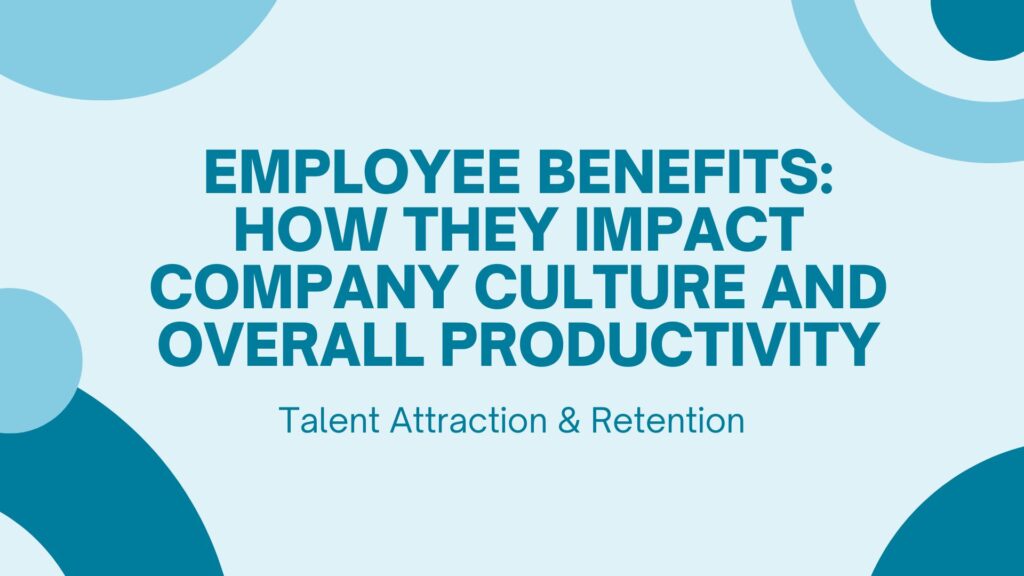Employee Benefits: How They Impact Company Culture and Overall Productivity

Discover how employee benefits boost company culture and productivity. Get expert insights, practical tips, and actionable strategies tailored for HR professionals in Hong Kong.
Introduction
Imagine walking into your office in Hong Kong and feeling an unmistakable buzz of energy—not just because of the city’s vibrant pace, but because your team is motivated, engaged, and truly cared for. That’s the power of well-crafted employee benefits. These perks are not merely a tick-box exercise; they’re a strategic investment in your people that can transform your company culture and drive overall productivity.Hong Kong HR Trends & Workplace Insights
In this post, I’ll share insights into how employee benefits shape company culture, enhance productivity, and ultimately lead to happier, more committed employees. Whether you’re an HR veteran or just starting your journey, this guide is designed to be your go-to resource for understanding the true impact of employee benefits.

What Are Employee Benefits and Why Are They Important?
Employee benefits are more than just the standard holiday allowance or pension plan. They include a range of perks—from health insurance and wellness programmes to flexible working hours and professional development opportunities—that together form a comprehensive package aimed at improving the overall well-being of your workforce.
Why They Matter:
- Enhancing Employee Engagement: When employees feel valued and supported, their engagement levels naturally soar.
- Boosting Satisfaction: Attractive benefits contribute to higher job satisfaction, reducing turnover rates.
- Strengthening Company Culture: A robust benefits package fosters a positive work environment, aligning employee values with your company’s vision.
- Driving Productivity: Healthy, happy employees are often more productive and innovative.
For more detailed insights, consider exploring SHRM’s comprehensive guide on employee benefits.
How Do Employee Benefits Influence Employee Engagement?
Employee engagement through benefits is a key area that many companies in Hong Kong are investing in. When employees see that their company is willing to invest in their well-being, it creates a strong sense of loyalty and commitment.
Key Elements of Engagement:
- Flexibility: Options such as remote work and flexible hours allow employees to balance work and life more effectively.
- Health and Wellbeing: Initiatives like gym memberships, mental health support, and wellness programmes contribute to a healthier, more engaged workforce.
- Professional Development: Funding for courses, certifications, and conferences not only develops skills but also shows employees that their growth is a priority.
A recent article on Harvard Business Review highlights that engaged employees are more likely to innovate and stay with the company longer. It’s all about creating an environment where employees feel seen and supported.
How Do Employee Benefits Affect Employee Satisfaction?
Employee satisfaction is the heartbeat of a thriving workplace. When your benefits align with the needs and aspirations of your employees, you’re not just boosting morale—you’re actively creating a more content and stable work environment.
The Impact on Satisfaction:
- Financial Security: Competitive salaries paired with comprehensive benefits such as pension plans and health insurance provide a safety net that reduces stress.
- Work-Life Balance: Benefits like flexible work arrangements and paid leave enable employees to recharge, leading to higher satisfaction levels.
- Recognition and Rewards: Employee satisfaction is further enhanced when benefits include performance bonuses, recognition programmes, or even small perks like subsidised lunches.
This combination of factors is instrumental in not only attracting but also retaining top talent. In fact, Forbes Human Resources Council recently outlined how targeted benefits can directly increase employee satisfaction and, in turn, productivity.
What Is the Relationship Between employee benefits & productivity?
When you invest in your employees, you invest in the overall success of your organisation. Productivity isn’t just about the hours clocked in—it’s about how effectively your team works and innovates.
How Benefits Drive Productivity:
- Healthier Employees: Good health benefits reduce absenteeism and ensure that employees are performing at their best.
- Enhanced Morale: When employees feel their well-being is a priority, they’re more motivated to contribute meaningfully.
- Efficiency through Engagement: Engaged employees tend to be more efficient, turning benefits into tangible ROI.
- Retention: Lower turnover means less time and resources spent on hiring and training new staff, leading to a more stable, experienced workforce.
A recent Gartner press release reinforces that companies offering robust employee benefits see a measurable improvement in ROI due to enhanced productivity and reduced recruitment costs.
Secondary Insights: Deep Dive into Related Areas
To further understand the multi-faceted benefits of employee perks, let’s explore some related topics.
Employee Benefits Impact Employee Morale
Employee morale is the invisible force that drives your daily operations. High morale translates into a positive workplace atmosphere, reducing stress and encouraging collaboration. When employees feel that their needs are met through well-structured benefits, morale soars, leading to a more cohesive team.
Key Takeaways:
- Recognition: Small perks like appreciation events or birthday celebrations can make a big difference.
- Support: Access to mental health resources and stress management programmes shows that you care.
- Community: Benefits that promote social interaction, such as team outings or wellness challenges, help build a strong community within your company.
Employee Engagement Through Benefits
The link between employee engagement and benefits is clear. When you offer benefits that truly resonate with your team, you create a culture of engagement where every individual feels part of the company’s journey.
How to Enhance Engagement:
- Personalisation: Tailor benefits to meet the diverse needs of your workforce.
- Communication: Clearly articulate the value of each benefit so that employees understand how they enhance their daily lives.
- Feedback: Regularly seek input from your team to continually refine your benefits package.
Employee Satisfaction and Retention
Employee satisfaction and retention go hand in hand. A well-rounded benefits package is not only a tool for attracting talent but also for retaining it. When employees are satisfied, they are more likely to stick around and grow with your organisation.
Strategies to Improve Retention:
- Career Growth: Offer opportunities for advancement and continuous learning.
- Work Environment: Cultivate a supportive and inclusive company culture.
- Competitive Packages: Regularly review and update your benefits to stay competitive in the market.
Productivity and Benefits Programmes
Productivity is the ultimate goal of any effective benefits programme. By investing in employee wellbeing, you create an environment where productivity is the natural outcomeof a motivated and healthy workforce.
Elements That Drive Productivity:
- Efficiency Tools: Providing modern tools and technologies that facilitate seamless work processes.
- Wellbeing Initiatives: Programs focused on physical and mental health directly reduce downtime and absenteeism.
- Performance Incentives: Linking benefits with performance metrics encourages a results-driven culture.
Employee Benefits and Company Culture
The culture of your company is shaped by every decision you make, including how you care for your employees. A forward-thinking benefits programme can become a cornerstone of your company culture, signalling that you value not just the work, but the people behind it.
Building a Strong Culture:
- Inclusivity: Ensure that benefits are accessible and appealing to a diverse workforce.
- Transparency: Openly discuss how benefits align with your company’s values and goals.
- Celebration: Regularly celebrate achievements and milestones as part of your benefits programme.
 Data and Comparison: Traditional VS Modern Benefits
Data and Comparison: Traditional VS Modern Benefits
Sometimes a side-by-side comparison can help illustrate the transformative power of modern employee benefits. Check out the table below:
| Aspect | Traditional HR Practices | Modern HR with Enhanced Employee Benefits |
| Employee Engagement | Limited to basic perks | Comprehensive programmes including flexible working, wellness, and training |
| Employee Satisfaction | Basic salary and occasional bonuses | Personalised benefits leading to higher retention and morale |
| Productivity | Measured in hours worked, often with high absenteeism | Driven by engagement, lower absenteeism, and innovative work practices |
| Company Culture | Formal and rigid | Inclusive, supportive, and dynamic, reflecting modern values |
| ROI on HR Investments | Difficult to quantify, often lower ROI | Higher ROI due to improved performance and reduced turnover |
Insert image of an infographic comparing traditional vs modern employee benefits here.
Real-Life Anecdotes: Transforming Workplaces in Hong Kong
Let me share a story from a colleague at a bustling Hong Kong firm. Initially, the company offered standard benefits, and while the basics were covered, employee engagement was lacking. After a strategic overhaul that introduced more flexible working conditions, mental health resources, and personalised professional development opportunities, the transformation was remarkable. Not only did employee morale improve, but productivity also saw a significant boost, proving that a well-designed benefits programme can be a game-changer.
Lessons Learned:
- Start Small, Scale Gradually: Begin with pilot initiatives to gauge impact before rolling out company-wide changes.
- Communicate Effectively: Keep your team in the loop about new benefits and how they align with both personal and organisational goals.
- Celebrate Successes: Recognise and reward progress—small wins can build the momentum for larger successes.
This isn’t just a theory; it’s a proven strategy that resonates well in Hong Kong’s fast-paced business landscape.
Practical Tips for Implementing Effective Employee Benefits
If you’re considering a revamp of your benefits programme, here’s a practical roadmap to get you started:
- Assess Your Current Offerings:
Take stock of what you already offer and identify any gaps. Use surveys or one-on-one sessions to understand what your employees value most. - Benchmark Against Industry Standards:
Look at resources such as SHRM’s employee benefits guide to see how your offerings compare with industry best practices. - Tailour Benefits to Your Workforce:
Recognise that one size does not fit all. Consider flexible options that cater to different demographics, job roles, and personal needs. - Invest in Communication and Training:
Ensure your HR team and employees understand the value of the new benefits. Workshops and regular updates can help in this regard. - Measure, Review, and Adjust:
Set clear metrics to track the effectiveness of your benefits programme. Use data to continually refine your strategy and maximise ROI, as highlighted by Gartner’s latest research.
Expert Opinions and Credible Resources
It’s always wise to lean on expert insights when refining your HR strategy. As noted by thought leaders in the field, effective employee benefits are a cornerstone of robust company culture and enhanced productivity. For additional perspectives, I recommend exploring:
- Forbes on employee benefits that boost productivity and satisfaction
- Harvard Business Review’s take on how employee benefits impact engagement
These resources offer detailed case studies and data-backed insights that can help you refine your approach.
Conclusion
In today’s competitive business landscape, especially in a dynamic city like Hong Kong, employee benefits are not just a perk—they’re a strategic imperative. From boosting morale and engagement to driving productivity and nurturing a vibrant company culture, the right benefits programme can transform your organisation from the inside out.
To summarise:
- Employee benefits are a vital investment that improve engagement, satisfaction, and productivity.
- A modern benefits programme can significantly enhance company culture, making your workplace more inclusive, supportive, and dynamic.
- Strategic implementation, ongoing measurement, and regular updates are key to ensuring that your benefits remain relevant and effective.
I encourage you to take a close look at your current benefits strategy. Consider how you can integrate these insights to create a more dynamic, productive, and happy workplace. Remember, the journey to a better work environment starts with one step—an investment in your people.
Call to Action:
If you found this guide helpful, please share it with your colleagues and join the conversation. Let’s work together to create workplaces where every employee feels valued and empowered. Drop your thoughts in the comments below or connect with me on LinkedIn for more insights on modern HR practices.
Final Thoughts
Employee benefits are much more than just financial perks—they’re about creating a culture where employees feel seen, supported, and inspired to perform their best. As HR professionals in Hong Kong, you have a unique opportunity to shape a work environment that not only meets business objectives but also nurtures the human spirit. Embrace innovation, listen to your team, and watch as your organisation transforms into a powerhouse of productivity and positivity.
Thank you for taking the time to read this guide. I look forward to hearing your success stories and learning how you’ve implemented effective benefits programmes in your organisations. Until next time, here’s to building better, happier workplaces in Hong Kong!
